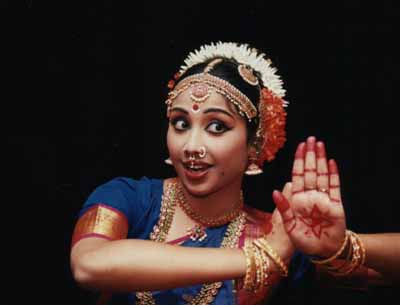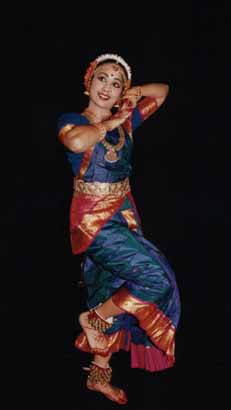Kuchipudi is the classical dance form from the South-East Indian state of Andhra Pradesh. It derives its name from the village of Kuchelapuram, a small village about 65 kms from Vijaywada. It is known for its graceful movements and its strong narrative / dramatic character.

History of Kuchipudi
There is a legend concerning the origins of Kuchipudi. It is said that there was once an orphan of Srikakulam who was raised by the village. These kind people had him married at childhood as was the custom of the time. However, for his training he went to Udipi for Vedic studies. During his study he acquired the name Sidhendra Yogi.
 |
| Durga Pallavi in Kuchipudi Pose |
After a time he returned to Srikakulam. However, the village elders ordered him to go to his wife’s house to assume his family responsibilities. On the journey he came upon a river. As he was swimming across the river he suddenly realised that he could swim no further. He then prayed to God to give him the strength to make it across. He did make it, and upon reaching the shore he vowed to become a sanyasi (renunciate) and devote his life to religious affairs.
He then settled in the village of Kuchelapuram and started teaching. Here, he instructed Brahmin boys in devotional dance dramas based upon religious themes. These religious plays were presented as offerings to God in the tradition of the Natya Shastra.
Kuchipudi flourished as a dramatic form of dance for hundreds of years. It was held in high esteem by the rules of the Deccan. For instance Tana Shah in 1678 granted the lands around Kuchipudi to the Brahmins who performed the dance.

At times the dancers could even wield political and social power. One example was a play-cum-social commentary performed in 1502. It seems that a group of artists performed before Immadi Narasa Nayaka. In this play, they indicated that the people were being unfairly treated by a local raja. The dancers succeeded in freeing the people form the abusive practices of the raja, but the artists at one point even required the protection of the army.
Modern Kuchipudi acquired its present form in the 20th century. A number of people were responsible for moving it from the villages to the performance stage. One of the most notable was guru Lakshminarayan Shastry. After him, a number of other luminaries would mould it into its present shape. Some notable names are Vempati Chinna Satyam, C.R. Acharyalu, and Dr. Nataraja Ramakrishna.
Musical Instruments Used To Accompany Kuchipudi
The instrumentation in Kuchipudi is similar to that of Bharat Natyam. The drone is provide by the tanpura and/or the surpeti. The rhythmic accompaniment is provided by the mridangam and the manjira. These may be backed up by kanjira, murchang or ghatam. The melodic accompaniment may be handled by veena (Saraswati veena), venu, or violin. There is additional rhythmic accompaniment provided by the ghungharu on the dancer’s feet.
Selected Video
Other Sites of Interest
On Filming Classical Indian Dance
The Limits Of Orientalism: Classical Indian Dance And The Discourse Of Heritage
From interculturalism to historicism: reflections on classical Indian dance (2000/1)
Classical Indian Dance in Literature and the Arts Kapila Vatsyayan (Book Review)
From: Bodies that Matter: on the Discursive Limits of ‘sex'
The Theory and Technique of Classical Indian Dancing
From Interculturalism to Historicism: Reflections on Classical Indian Dance
Classical Indian Dance and Women’s Status
Bharata Natyam: A Classical Indian Dance in Transition
